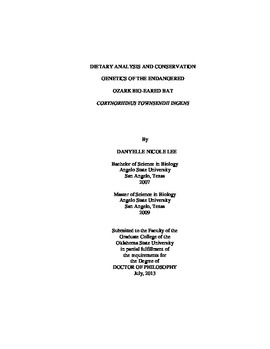| dc.contributor.advisor | Van Den Bussche, Ronald A. | |
| dc.contributor.author | Lee, Danyelle Nicole | |
| dc.date.accessioned | 2014-09-24T14:17:01Z | |
| dc.date.available | 2014-09-24T14:17:01Z | |
| dc.date.issued | 2013-07 | |
| dc.identifier.uri | https://hdl.handle.net/11244/11027 | |
| dc.description.abstract | Populations of endangered Ozark big-eared bats (Corynorhinus townsendii ingens) are restricted to 19 essential maternity caves or hibernacula in Oklahoma and Arkansas and total only 1,600-1,800 individuals. Effective conservation and management should encompass many aspects of the species natural history and genetics. | |
| dc.description.abstract | This dissertation first presents a list of insect species consumed by Ozark bigeared bats which can be used to better understand habitat selection if influenced by prey availability. Traditionally, diet studies have relied on morphological analysis of prey body parts found in fecal material, but that method can overlook species because key features used in identification might be damaged by chewing, digestion, or decomposition after excretion. I used molecular analysis of cytochrome c oxidase gene from prey DNA found in bat fecal material to identify 20 insect species from nine families and two orders. Fifteen of these were unknown prey items for this taxon. Notodontids were found in the majority of samples (64.3%) and were consumed in greater proportion than their abundance in the environment. | |
| dc.description.abstract | The fragmented nature of populations of Ozark big-eared bats make them susceptible to reduced levels of genetic variation, inbreeding, or fixation of deleterious alleles from genetic drift. For my second chapter, I developed 15 polymorphic nuclear microsatellites to be used in the third chapter with mitochondrial D-loop DNA sequence to characterize the population genetics of these bats and determine conservation units. Molecular data suggested that genetic mixing is occurring at swarming sites among geographically close colonies within Oklahoma but does not include an Arkansas population. I recommend colonies in eastern Oklahoma and western Arkansas be managed as two separate units to protect unique alleles but with protection of surrounding habitat to facilitate low levels of gene flow. Additional genetic analysis of isolated populations in Marion Co., Arkansas is warranted because they may be a separate management unit. Finally, comparison of genetic characteristics of current populations to those 10 years earlier suggested considerable change in gene frequencies, likely as a result of genetic drift. Decreases in genetic variation could potentially affect popoulaitons of Ozark big-eared bats so I strongly recommend continued genetic monitoring. | |
| dc.format | application/pdf | |
| dc.language | en_US | |
| dc.rights | Copyright is held by the author who has granted the Oklahoma State University Library the non-exclusive right to share this material in its institutional repository. Contact Digital Library Services at lib-dls@okstate.edu or 405-744-9161 for the permission policy on the use, reproduction or distribution of this material. | |
| dc.title | Dietary analysis and conservation genetics of the endangered Ozark big-eared bat Corynorhinus townsendii ingens | |
| dc.contributor.committeeMember | Hamilton, Meredith J. | |
| dc.contributor.committeeMember | Echelle, Anthony A. | |
| dc.contributor.committeeMember | Ammerman, Loren K. | |
| dc.contributor.committeeMember | Leslie, David M., Jr. | |
| osu.filename | Lee_okstate_0664D_12940.pdf | |
| osu.accesstype | Open Access | |
| dc.type.genre | Dissertation | |
| dc.type.material | Text | |
| thesis.degree.discipline | Zoology | |
| thesis.degree.grantor | Oklahoma State University | |
